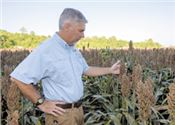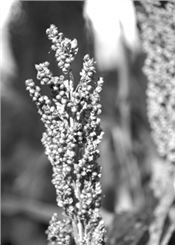|
Harvest Is Well Underway On Reduced Sorghum Acres

Grain sorghum acreage was low this year because of low prices and
sugarcane aphid problems. Mississippi State University Extension Service specialist
Erick Larson examined sorghumready for harvest Sept. 15, 2016, at MSU’s
R.R. Foil Plant Science Research Center in Starkville, Mississippi.
Photo by MSU Extension
STARKVILLE, MISS.
Grain sorghum acres are very low in the state, a response to prices returning to their usual range and sugarcane aphids continuing to be a scourge to the crop.
Officials estimate Mississippi has just 20,000 acres of grain sorghum. In 2015, the state had at least five times that number, said Erick Larson, grain specialist with the Mississippi State University Extension Service.
“The crop this year is well down from traditional acreage, and acreage last year would have been down substantially were it not for a unique marketing situation where the price offered for grain sorghum was well above the traditional standard,” Larson said. “That promoted and encouraged sorghum acres last year.”
This year, that price incentive was not there, but the problem with sugarcane aphids remained.
“Sugarcane aphids can be a catastrophic problem and something that requires intensive scouting and multiple insecticide applications throughout the year to control,” Larson said. “Control is possible, but costly, and it has to be scouted throughout the growing season.”
The U.S. Department of Agriculture estimated that by Sept. 11, the sorghum crop was 83 percent mature and 50 percent harvested. USDA characterized the crop as 61 percent good or excellent and 37 percent fair or poor.
Other than significant pressure from sugarcane aphids, Larson said the crop dealt with a little more heat and drought stress than normal. Frequent rains and high humidity through the first three weeks of August could cause some harvest problems.
“All the moisture and humidity, coupled with mature grain, can cause the kernels to sprout, which ruins the quality of the kernel,” Larson said.
Grain sorghum is a big crop in the western and southern Plains states like Kansas and Texas. In Mississippi, it is best suited for growing on heavy soils with limited productivity and in dryland or rain-fed acres in rotation with soybeans. The majority of the state’s acreage tends to be found near the Memphis market in Bolivar, Coahoma, Quitman, Tunica, Panola and DeSoto counties.
Larson called sorghum a secondary crop for most Mississippi growers.
“It’s a niche crop that does work very well in soils that are not considered to be highly productive,” he said. “It’s a great crop to use in rotation systems with cotton and soybeans, and it may help with the control of glyphosate-resistant palmer amaranth, or pigweed, because it allows different herbicide chemistry to be used that is very effective with those weeds.”
Unless prices move back up close to corn prices, sorghum acres are likely to stay low as long as the sugarcane aphid remains a problem.
Brian Williams, Extension agricultural economist, said Mississippi sorghum is currently trading for $2.98 per bushel, down from the $3.95 price it was selling for a year ago.
“A lot of what drove acreage lower was more favorable alternatives and a downturn in prices,” Williams said. “A year ago, the price difference between sorghum and corn was a positive 15 cents, but now sorghum is 35 cents below corn. Much of that is trade-driven. A year ago, demand was strong out of China, but it has since fallen off.”
When prices are poor, economics overcome grain sorghum’s production advantages.
“The biggest benefit for sorghum is that it is a relatively low-cost crop to grow, and it is very drought- and heat-tolerant compared to many of the alternatives,” he said. ∆
DR. ERICK J. LARSON: Associate Extension/Research Professor Mississippi State, Miss.

More than half of the state’s grain sorghum had been harvested by mid-September.
This sorghum was awaiting harvest Sept. 15, 2016 at Mississippi State University’s
R.R. Foil Plant Science Research Center in Starkville, Mississippi.
|
|